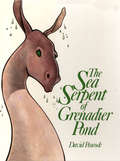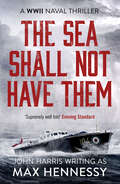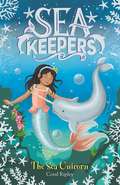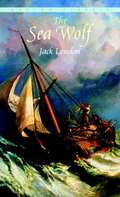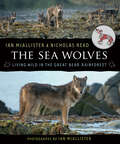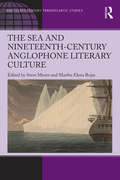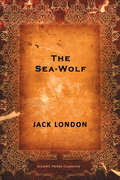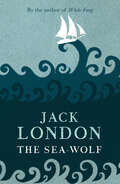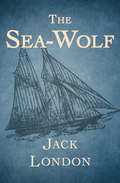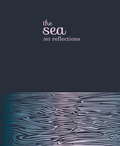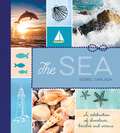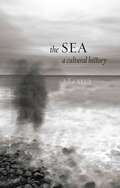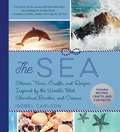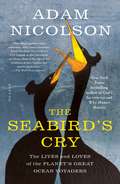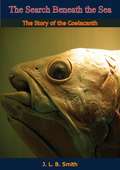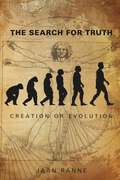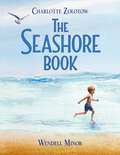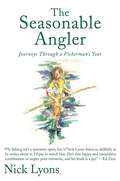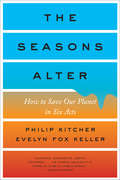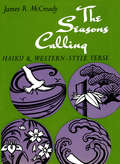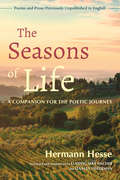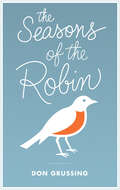- Table View
- List View
The Sea Serpent of Grenadier Pond
by David PeacockThis is a children’s book about the the sea serpent of Grenadier Pond.
The Sea Shall Not Have Them (The WWII Naval Thrillers)
by Max HennessyThe &“supremely well told&” classic war novel of espionage in the most extreme of situations—from the acclaimed author of Ride Out the Storm (Evening Standard). An essential flight from France crash lands in the North Sea, leaving the four remaining crew members of the RAF Hudson stranded on a dinghy. One man is critically injured, and another, a rocket expert, is carrying a briefcase stuffed with vital war secrets, that could prove devastating if allowed to fall into the wrong hands. As the days begin to stretch out, they can only pray that the rescue team can locate the dinghy in time, before exposure kills them, or worse, the enemy finds them . . . A novel which charts the daring and courage of four castaways, and the men who rescued them in a breathtaking mission with the most awesome of consequences, perfect for fans of Alexander Fullerton, David McDine, and Alan Evans.
The Sea Unicorn: Book 2 (Sea Keepers #2)
by Coral RipleyNarwhal to the rescue! The Sea Keepers set off on an icy adventure in this magical new series about saving our oceans.The Arctic mermaids urgently need the Sea Keepers' help! Evil mermaid Effluvia has used her bad magic to melt their ice palace. If Emily, Grace and Layla can't fix it, the poorly animals the mermaids look after will be in danger. The Sea Keepers are determined to save the sea animal sanctuary, but Effluvia has enchanted a pod of orcas to stop them. Can a friendly narwhal help them find the magic pearl and save the ice palace?
The Sea Wolf
by Jack LondonThe Sea Wolf is Jack London’s powerful and gripping saga of Humphrey Van Weyden, captured by a seal-hunting ship and now an unwilling sailor under its dreaded captain, Wolf Larsen. The men who sailed with Larsen were treacherous outcasts, but the captain himself was the legendary Sea Wolf–a violent brute of a man.Jack London was a worshipper of the strong and virtuous hero, and a firm believer in the inevitable triumph of good. The master storyteller nowhere demonstrates this theme more vividly than in this classic American tale of peril and adventure, good and evil.
The Sea Wolves: Living Wild in the Great Bear Rainforest
by Nicholas ReadThe Sea Wolves sets out to disprove the notion of "the Big Bad Wolf," especially as it is applied to coastal wolves—a unique strain of wolf that lives in the rainforest along the Pacific coast of Canada. Genetically distinct from their inland cousins and from wolves in any other part of the world, coastal wolves can swim like otters and fish like the bears with whom they share the rainforest. Smaller than the gray wolves that live on the other side of the Coast Mountains, these wolves are highly social and fiercely intelligent creatures. Living in the isolated wilderness of the Great Bear Rainforest, coastal wolves have also enjoyed a unique relationship with man. The First Nations people, who have shared their territory for thousands of years, do not see them as a nuisance species but instead have long offered the wolf a place of respect and admiration within their culture. Illustrated with almost one hundred of Ian McAllister's magnificent photographs, The Sea Wolves presents a strong case for the importance of preserving the Great Bear Rainforest for the wolves, the bears and the other unique creatures that live there.
The Sea and Nineteenth-Century Anglophone Literary Culture (Ashgate Series in Nineteenth-Century Transatlantic Studies)
by Steve Mentz Martha Elena RojasDuring the nineteenth century, British and American naval supremacy spanned the globe. The importance of transoceanic shipping and trade to the European-based empire and her rapidly expanding former colony ensured that the ocean became increasingly important to popular literary culture in both nations. This collection of ten essays by expert scholars in transatlantic British and American literatures interrogates the diverse meanings the ocean assumed for writers, readers, and thinkers on both sides of the Atlantic during this period of global exploration and colonial consolidation. The book’s introduction offers three critical lenses through which to read nineteenth-century Anglophone maritime literature: "wet globalization," which returns the ocean to our discourses of the global; "salt aesthetics," which considers how the sea influences artistic culture and aesthetic theory; and "blue ecocriticism," which poses an oceanic challenge to the narrowly terrestrial nature of "green" ecological criticism. The essays employ all three of these lenses to demonstrate the importance of the ocean for the changing shapes of nineteenth-century Anglophone culture and literature. Examining texts from Moby-Dick to the coral flower-books of Victorian Australia, and from Wordsworth’s sea-poetry to the Arctic journals of Charles Francis Hall, this book shows how important and how varied in meaning the ocean was to nineteenth-century Anglophone readers. Scholars of nineteenth-century globalization, the history of aesthetics, and the ecological importance of the ocean will find important scholarship in this volume.
The Sea of Silence
by Seth HunterThe seventh volume in the thrilling adventure series featuring Nathan Peake, British naval officer and spy, during the French Revolutionary and Napoleonic WarsThe war moves to the Americas as Captain Nathan Peake, freed from service in the Royal Navy, is secretly commissioned by President Thomas Jefferson to command a naval operation in the Caribbean Sea and frustrate plans to establish a new French Empire on the North American mainland which would pose an existential threat to the infant United States.With Europe temporarily at peace, Napoleon Bonaparte has dispatched his victorious army with a vast fleet to the Caribbean. Its aim is to re-impose French authority in the region, and then occupy a vast swathe of territory stretching from New Orleans to the Canada border and westward from the Mississippi to the Rocky Mountains. But first they must reconquer Saint-Domingue (now Haiti), where they are opposed by rebel slaves led by the African general Toussaint L'Ouverture. Nathan is sent from England with a small squadron crewed by British and American sailors, tasked with disrupting French supply lines at sea and running guns to the rebel forces. But if the men are caught, they will be disowned by the British and US governments and very likely hanged by the French as pirates. This adventure will lead Nathan into a running battle with the French Navy in the troubled waters off Saint-Domingue, an increasingly desperate involvement in one of the most brutal colonial conflicts in history, a dangerous liaison with Pauline Bonaparte, sister of Napoleon and wife of the French commander, and a battle of ideas and ideologies that persists to the present day.
The Sea-Wolf
by Jack LondonThe Sea-Wolf is a 1904 psychological adventure novel by American novelist Jack London. The book's protagonist, Humphrey van Weyden, is a literary critic who is a survivor of an ocean collision and who comes under the dominance of Wolf Larsen, the powerful and amoral sea captain who rescues him. London's intention in writing The Sea-Wolf was "an attack on (Nietzsche's) super-man philosophy."[8] Nietzsche and Schopenhauer are mentioned in the second sentence of the novel as the preferred reading of the friend Humphrey van Weyden visited before his shipwreck. The novel also contains references to Herbert Spencer in chapters 8, 10, Charles Darwin in chapters 5, 6, 10, 13, Omar Khayyám in chapters 11, 17, 26, Shakespeare in chapter 5, and John Milton in chapter 26. Like The Call of the Wild, The Sea Wolf tells the story of a soft, domesticated protagonist — in this novel's case an intellectual man named Humphrey van Weyden — forced to become tough and self-reliant by exposure to cruelty and brutality. The plot has some initial similarities to Captains Courageous by Rudyard Kipling in that they each have an idle, rich young man rescued from the sea and shanghaied into becoming a working sailor; however, the two stories differ widely in plot and moral tone.
The Sea-Wolf (Hesperus Classics)
by Jack LondonJack London's thrilling narrative of the seven seas remains just as gripping today as it was 100 years agoA classic tale of adventure at sea, this is the story of the naïve young Humphrey van Weyden, whose ship is wrecked in a terrible storm. He is rescued by the mysterious Captain Wolf Larsen of the ship Ghost. Humphrey's new life aboard Ghost will test him to the limits of his endurance but also bring him the greatest happiness he has ever known. Captain Wolf Larsen is a powerful, brutal man with a razor sharp intelligence. When there is an attempted mutiny on board he shows no mercy to the would-be mutineers, and when his brother Death Larsen attempts to take over the Ghost by force, there is no love lost between them in their vicious battle. Wolf's cruel manner is thrown into sharp relief by the gentle spirit of the beautiful poetess also rescued, Maud Brewster, who charms both Wolf and Humphrey. As Humphrey falls in love with Maud, he must contend not only with the dangers of being at sea but with competition from his cruel and scheming captain. This dramatic tale of mutiny and shipwreck is at its heart the story of a love that flourishes in the unlikeliest of places.
The Sea-Wolf: Large Print
by Jack LondonIn one of the greatest sea stories ever told, a writer discovers his true nature in confrontation with a mad ship captain As Humphrey van Weyden rides a ferry across San Francisco Bay, he reflects proudly on the publication of his latest essay in the Atlantic. When a sudden collision rips a hole in the ship&’s hull, the ferry sinks like a stone, throwing the literary critic into the icy harbor. Rescued by the Ghost, a seal-hunting vessel, van Weyden counts his blessings. Little does he know he&’s boarded a ship bound straight for hell. Brilliant and amoral, Capt. Wolf Larsen rules the Ghost with an iron fist. Forced into backbreaking service as a cabin boy, van Weyden watches helplessly as Larsen terrorizes his crew. But when mounting tensions finally result in outright mutiny, the mild-mannered intellectual will be forced to take a stand against the ruthless tyrant who saved his life. A rousing tale of adventure inspired by author Jack London&’s own maritime experiences, The Sea-Wolf has influenced writers including Ernest Hemingway, George Orwell, and Jack Kerouac. This ebook has been professionally proofread to ensure accuracy and readability on all devices.
The Sea: 365 reflections
by The Sea 365 reflectionThroughout history, legend and myth, the sea has symbolized power and freedom, strength and serenity and has inspired poets, philosophers, astronomers and artists. Reflections upon the sea from literature, philosophy, science and ancient wisdom are gathered together in this enchanting collection.
The Sea: A Celebration of Shorelines, Beaches and Oceans
by Isobel CarlsonFor thousands of years, the sea has stirred our imagination, and awed us with its beauty and power. Whether we experience it from the top of a blustery cliff or from the shelter of a sandy cove, from aboard a ship in a busy harbour or from the rush of a surf board, the might of the ocean is something that continues to inspire us.
The Sea: A Cultural History
by John Mack"There is nothing more enticing, disenchanting, and enslaving than life at sea," wrote Joseph Conrad. And there is certainly nothing more integral to the development of the modern world. In The Sea: A Cultural History, John Mack considers those great expanses that both unite and divide us and the ways in which human beings interact because of the sea, from navigation to colonization to trade. Much of the world's population lives on or near the coast, and as Mack explains, in a variety of ways, people actually inhabit the sea. The Sea looks at the characteristics of different seas and oceans and investigates how the sea is conceptualized in various cultures. Mack explores the diversity of maritime technologies, especially the practice of navigation and the creation of a society of the sea, which in many cultures is all-male, often cosmopolitan, and always hierarchical. He describes the cultures and the social and technical practices characteristic of seafarers, as well as their distinctive language and customs. As he shows, the separation of sea and land is evident in the use of different vocabularies on land and on the sea for the same things, the change in a mariner's behavior when on land, and in the liminal status of points uniting the two realms, like beaches and ports. Mack also explains how ships are deployed in symbolic contexts on land in ecclesiastical and public architecture. Yet despite their differences, the two realms are always in dialogue in symbolic and economic terms. Casting a wide net, The Sea uses histories, maritime archaeology, biography, art history, and literature to provide an innovative and experiential account of the waters that define our worldly existence.
The Sea: Stories, Trivia, Crafts, and Recipes Inspired by the World's Best Shorelines, Beaches, and Oceans
by Isobel Carlson“The sea is as near as we come to another world.” —Anne Stevenson This book celebrates oceans, coasts and shorelines the world over. Bringing together incredible stories and legends of the sea, delicious recipes and activities inspired by the coast, and fascinating trivia on everything from marine exploration to the turning tides, it will captivate anyone who is enthralled by the wonder of the sea.Learn about sea creatures, such as turtles, jellyfish, whales, sharks, and dolphinsDish up delicious recipes and drinks, such as seafood paella, potted shrimp, halloumi kebabs, and mint iced teaGet creative with crafts, such as driftwood art, seashell art, and building your own raftThe Sea is beautiful and practical, delivering lessons on maritime history, coastline formations and features, famous lighthouses and shipwrecks, and myths and legends of the ocean while also offering do-it-yourself projects and encouragement for the more adventurous beach-goer who may want to try activities such as sailing, kayaking, windsurfing, kitesurfing, wild camping, fossil hunting, and building beach bonfires.
The Seabird's Cry: The Lives and Loves of the Planet's Great Ocean Voyagers
by Adam NicolsonLife itself could never have been sustainable without seabirds. As Adam Nicolson writes: "They are bringers of fertility, the deliverers of life from ocean to land."A global tragedy is unfolding. Even as we are coming to understand them, the number of seabirds on our planet is in freefall, dropping by nearly 70% in the last sixty years, a billion fewer now than there were in 1950. Of the ten birds in this book, seven are in decline, at least in part of their range. Extinction stalks the ocean and there is a danger that the grand cry of the seabird colony, rolling around the bays and headlands of high latitudes, will this century become little but a memory.Seabirds have always entranced the human imagination and NYT best-selling author Adam Nicolson has been in love with them all his life: for their mastery of wind and ocean, their aerial beauty and the unmatched wildness of the coasts and islands where every summer they return to breed. The seabird’s cry comes from an elemental layer in the story of the world.Over the last couple of decades, modern science has begun to understand their epic voyages, their astonishing abilities to navigate for tens of thousands of miles on featureless seas, their ability to smell their way towards fish and home. Only the poets in the past would have thought of seabirds as creatures riding the ripples and currents of the entire planet, but that is what the scientists are seeing now today.
The Search Beneath the Sea: The Story of the Coelacanth
by J. L. B. SmithONE OF THE GREAT BOOKS OF SCIENTIFIC ADVENTURE…STRANGER THAN FICTIONOne of the most sensational discoveries in natural history, told by the ichthyologist who was directly involved in its first capture off the South African coast in 1938. Prior to this, the fish, although known to scientists, was thought to have become extinct at least fifty million years ago. There was much professional scepticism that it was indeed a coelacanth and Professor Smith had many battles ahead of him before proof could be found.A remarkable story.
The Search for Truth: Creation or Evolution
by Jaan RanneIs there any scientific merit to the creationist point of view? This book looks at that question in detail and studies the flaws of evolutionary thinking and even the lack of true science in the evolution model. The creation model can be backed up scientifically. The book looks at topics like dinosaurs coexisting with man, the flood, the age of the Earth, and the intelligence of early man.
The Seashell
by Michele DufresneJack and Daisy go to the beach with Bella and Rosie. Daisy wants to hunt for seashells but Bella and Rosie say Jack and Daisy are too little.
The Seashore Book
by Charlotte ZolotowA summer classic by two masters, reissued and redesigned for contemporary audiences.Wendell Minor&’s elegant artwork and Charlotte Zolotow&’s simple, evocative prose brings a day at the beach vividly to life as a boy and his mother imagine what it would be like to spend a day at the seashore. Hunting for seashells and building sandcastles, this tribute to the power of imagination and the tenderness of a mother-child connection is also a sweet ode to summer's greatest pastimes. Perfect for storytime or bedtime.
The Seasonable Angler: Journeys Through a Fisherman's Year
by Nick LyonsNick Lyons's first fishing book, The Seasonable Angler, is the story of a fisherman's year, from the projects and fantasies of an angler's winter through the thrill of a June evening's rise on the Beaverkill, and on to the pleasures and melancholia of autumn trout fishing.In a book of spirited contrasts, Nick Lyons recounts hilarious misadventures on opening day and on family trips, as well as quiet moments when the fisherman becomes contemplative and close to nature. Lyons captures the excitement of catching a first trout-and the sadness of having killed, at times, too many fish. There is an increasing respect for the natural world, for conservation, and for the spirit of the sport.Throughout The Seasonable Angler, Lyons evokes the humor and lore of a man who has loved fishing deeply since early childhood. His book is not only for avid fishermen, but also for everyone who appreciates fine writing about nature and who wants to understand what animates that strong clan of people who fish.
The Seasons Alter: How to Save Our Planet in Six Acts
by Evelyn Fox Keller Philip KitcherA landmark work of environmental philosophy that seeks to transform the debate about climate change. As the icecaps melt and the sea levels rise around the globe—threatening human existence as we know it—climate change has become one of the most urgent and controversial issues of our time. For most people, however, trying to understand the science, politics, and arguments on either side can be dizzying, leading to frustrating and unproductive debates. Now, in this groundbreaking new work, two of our most renowned thinkers present the realities of global warming in the most human of terms—everyday conversation—showing us how to convince even the most stubborn of skeptics as to why we need to act now. Indeed, through compelling Socratic dialogues, Philip Kitcher and Evelyn Fox Keller tackle some of the thorniest questions facing mankind today: Is climate change real? Is climate change as urgent as the “scientists” make it out to be? How much of our current way of life should we sacrifice to help out a generation that won’t even be born for another hundred years? Who would pay for the enormous costs of making the planet "green?" What sort of global political arrangement would be needed for serious action? These crucial questions play out through familiar circumstances, from an older husband and wife considering whether they should reduce their carbon footprint, to a first date that evolves into a passionate discussion about whether one person can actually make a difference, to a breakfast that becomes an examination over whether or not global warming is really happening. Entertaining, widely accessible, and thoroughly original, the result promises to inspire dialogue in many places, while also giving us a line of reasoning that explodes the so-far impenetrable barriers of obfuscation that have surrounded the discussion. While the Paris Agreement was an historic achievement that brought solutions within the realm of possibility, The Seasons Alter is a watershed book that will show us how to make those possibilities a reality.
The Seasons Calling: Haiku & Western-Style Verse
by James R. Mccready Wakana KozawaThis collection of haiku and Western-style verse by an American living in Japan brings a special poetic vision to the endless cycle of life, and to its separate rhythmic movements. <P><P>Readers will find again and again in these pages the sharpened sensibility and clear observation developed by the haiku discipline.One of the aims of this book, according to its author, is to reveal the similarities between haiku and Western-style verse. Its undeniable achievement is a rediscovery of the universals of emotion and expression uniting all people. In Haiku style, though not always in haiku form, these poems invite the reader to a poignant perception of identity in apparently unrelated things and people--a Westerner falling in love or out of love with Japan; a country girl dazzled by Ginza's bright lights; a sleeper wakened by "all-night thunder," wondering "who can dream of the old days with, such violence"; a wanderer among the tombstones of Tokyo or a New England cemetery. And readers will find again in these pages the sharpened sensibility and clear observation developed by haiku discipline.
The Seasons of Arnold's Apple Tree
by Gail GibbonsThis book about nature and the changing seasons focuses on a young boy and a very special apple tree. In Gail Gibbons's bright illustrations, Arnold collects apple blossoms in spring, builds a tree house in summer, makes apple pie and cider in the fall, and hangs strings of popcorn and berries for the birds in winter, among other seasonal activities. Includes a recipe for apple pie and a description of how an apple cider press works.
The Seasons of Life: A Companion for the Poetic Journey--Poems and Prose Previously Unpublished in English
by Hermann HesseA never-before-seen volume of poetry by the preeminent poet laureate Herman Hesse--a beautiful companion to Seasons of the Soul and the author's better-known prose work.Organized into four parts--spring, summer, autumn, and winter--The Seasons of Life relates the transitions in nature to the organic progressions of human life from birth through death. From the mundane to the sublime, the spiritual to the political, and private feeling to expressed opinion, Hesse touches on the range of human experience, inviting the reader to consider both the beauty and what Hesse called the "adversities of life."Beloved by readers as a wise and open friend, Hesse offers in this never-before-translated volume an honest portrayal of a whole life: its lessons and mysteries, its glories and despairs. The poet's voice--so treasured in his novels among a worldwide English-speaking audience--can now be enjoyed through this new translation in the follow-up to Seasons of the Soul.
The Seasons of the Robin (Mildred Wyatt-Wold Series in Ornithology)
by Don GrussingIn a small nest in a large oak tree, the drama begins. A young American Robin breaks open his shell and emerges into a world that will provide the warmth of sunny days and the life-threatening chill of cold, rainy nights; the satisfaction of a full stomach and the danger of sudden predator attacks; and the chance to mature into an adult robin who’ll begin the cycle of life all over again come next spring. In The Seasons of the Robin, Don Grussing tells the uncommon life story of one of the most common birds, the North American Robin. Written as fiction to capture the high drama that goes on unnoticed right outside our windows, the book follows a young male robin through the first year of life. From his perspective, we experience many common episodes of a bird’s life—struggling to get out of the egg; awkwardly attempting to master flight; learning to avoid predators; migrating for the first time; returning home; establishing a territory; finding a mate; and beginning the cycle again. This creative approach of presenting natural history through a fictional, yet factually based, story allows us to experience the spine-tingling, nerve-wracking, adrenaline-flowing excitement that is so much a part of the life of every wild thing. As Don Grussing concludes in his preface, “Once you experience the world through a robin’s eyes, I hope you’ll look at every wild thing with new appreciation and respect for what they accomplish by living.”
